
Gateway Arch National Park is an American national park located in St. Louis, Missouri, near the starting point of the Lewis and Clark Expedition.

Carl Milles was a Swedish sculptor. He was married to artist Olga Milles and brother to Ruth Milles and half-brother to the architect Evert Milles. Carl Milles sculpted the Gustaf Vasa statue at the Stockholm Nordic Museum, the Poseidon statue in Gothenburg, the Orpheus group outside the Stockholm Concert Hall, and the Fountain of Faith in Falls Church, Virginia. His home near Stockholm, Millesgården, became his resting place and is now a museum.

Malcolm W. Martin Memorial Park is a park on the east side of the Mississippi River in East St. Louis, Illinois, directly across from the Gateway Arch and the city of St. Louis, Missouri. For 29 years, tts major feature was the Gateway Geyser, a fountain that lifted water up to 630 feet (192 m) the same height as the Arch. Four smaller fountains around the Geyser represent the four rivers which converge near the two cities: The Mississippi, Missouri, Illinois, and Meramec. It was closed in 2023 due to costs of refurbishment and to hopefully prepare the park for handing over to the National Park Service as an extension to the Gateway memorial. The park also includes an elevated viewing point overlooking the river.

The American Bottom is the flood plain of the Mississippi River in the Metro East region of Southern Illinois, extending from Alton, Illinois, south to the Kaskaskia River. It is also sometimes called "American Bottoms". The area is about 175 square miles (450 km2), mostly protected from flooding in the 21st century by a levee and drainage canal system. Immediately across the river from St. Louis, Missouri, are industrial and urban areas, but nearby marshland, swamps, and the Horseshoe Lake are reminders of the Bottoms' riparian nature.

The Missouri State Capitol is the home of the Missouri General Assembly and the executive branch of government of the U.S. state of Missouri. Located in Jefferson City at 201 West Capitol Avenue, it is the third capitol to be built in the city. The domed building, designed by the New York City architectural firm of Tracy and Swartwout, was completed in 1917.
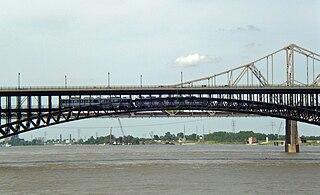
Transportation in Greater St. Louis, Missouri includes road, rail, ship, and air transportation modes connecting the bi-state St. Louis metropolitan area with surrounding communities throughout the Midwest, national transportation networks, and international locations. The Greater St. Louis region also supports a multi-modal transportation network that includes bus, paratransit, and light rail service in addition to shared-use paths, bike lanes and greenways.
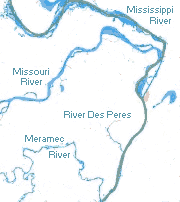
The Great Rivers Greenway District is a public agency created in 2000 to develop a regional network of greenways. Great Rivers Greenway engages citizens and community partners to plan, build and care for the greenways. In its first 20 years the agency built more than 128 miles of greenways connecting parks, rivers, schools, neighborhoods, business districts and transit.
Meeting of the Waters and similar constructs may refer to:

Henri-Léon Greber was a French sculptor, and medallist. His son was the architect Jacques Gréber. Active in the United States, he produced a fountain sculpture of four equestrian statues for Harbor Hill in 1910, and the copy of The Kiss in the Philadelphia Rodin Museum.

The Gateway Mall in St. Louis, Missouri is an open green space running linearly, one block wide, from the Gateway Arch at Memorial Drive to Union Station at 20th Street. Located in the city's downtown, it runs between Market Street and Chestnut Street.
The numbered streets of St. Louis, Missouri generally run north–south through the city, starting with 1st Street at the Mississippi River, and increasing in value the further west they are. 1st through 25th Streets are primarily centered around the Downtown and Downtown West neighborhoods, with many extending further north and south into other neighborhoods. There are a few other higher value streets that appear elsewhere in the St. Louis area, and although they are not adjacent to the 1st–25th grid in the eastern part of the city, their numberings in relation to their distances from the river are relatively consistent.
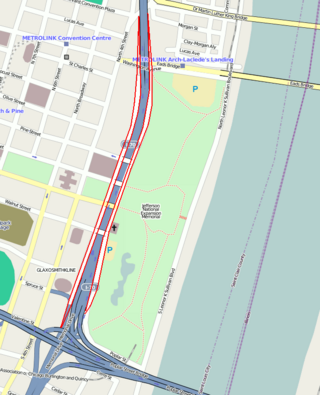
Memorial Drive runs north–south in Downtown St. Louis, Missouri. It is between the city's central business district and the grounds of the Gateway Arch and Gateway Arch National Park. It has an intimate relationship with Interstate 44 ; for most of its length, it runs above the sunken highway, but north of Washington Avenue it goes under it as the highway ramps up above the city.

The Iconography of St. Louis, Missouri is strongly informed by the city's French and German heritages, physical features, and place in American history.
The streets of St. Louis, Missouri, United States, and the surrounding area of Greater St. Louis are under the jurisdiction of the City of St. Louis Street Department. According to the department's Streets Division, there are 1,000 miles (1,600 km) of streets and 600 miles (970 km) of alleys within the city.
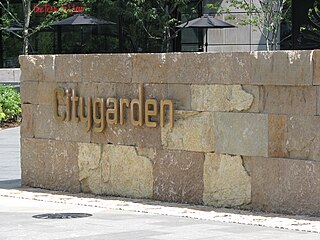
Citygarden is an urban park and sculpture garden in St. Louis, Missouri owned by the City of St. Louis but maintained by the Gateway Foundation. It is located between Eighth, Tenth, Market, and Chestnut streets, in the city's "Gateway Mall" area. Before being converted to a garden and park, the site comprised two empty blocks of grass. Citygarden was dedicated on June 30, 2009, and opened one day later, on July 1, 2009.
Parks in Greater St. Louis are administered by a variety of state, county, and municipal authorities. The region also is home to Gateway Arch National Park, site of the Gateway Arch, the only National Memorial in the state of Missouri. Among the largest municipal parks is Forest Park, which is 1,293 acres (5.2 km2) and is located in the city of St. Louis, although both Greensfelder County Park and Creve Coeur Park in St. Louis County are larger, at 1,646 and 2,114 acres respectively. St. Louis County is also the location of two large state parks, Babler State Park with 3.8 square miles (9.8 km2) and Castlewood State Park with 2.8 square miles (7.3 km2). The largest state park in the region is Meramec State Park, located near Sullivan, Missouri, with 10.8 square miles (28 km2) of parkland.

Charles Eugene Tefft was an American sculptor born in Brewer, Maine. His statue of Hannibal Hamlin is one of Maine's two statues in the National Statuary Hall Collection located in the US Capitol in Washington D.C. A second Tefft statue of Hamlin stands in Norumbega Mall in downtown Bangor, Maine.
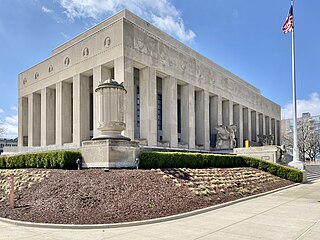
Memorial Plaza is a public park in the Downtown West neighborhood of St. Louis, Missouri. The park makes up the center section of the Gateway Mall and contains memorials honoring St. Louis veterans of World War I, World War II, and the Korean and Vietnam wars. The park extends from Tucker Boulevard to 18th Street between Market and Chestnut streets and is surrounded by the Central Branch of the St. Louis Public Library, St. Louis City Hall, the former Municipal Courts building, the Stifel Theatre, and the main St. Louis Post Office.
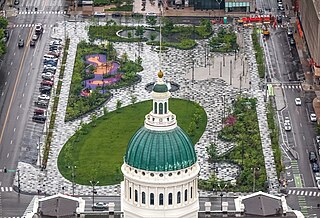
Kiener Plaza is a public park in downtown St. Louis, Missouri and is a part of the Gateway Mall.

















